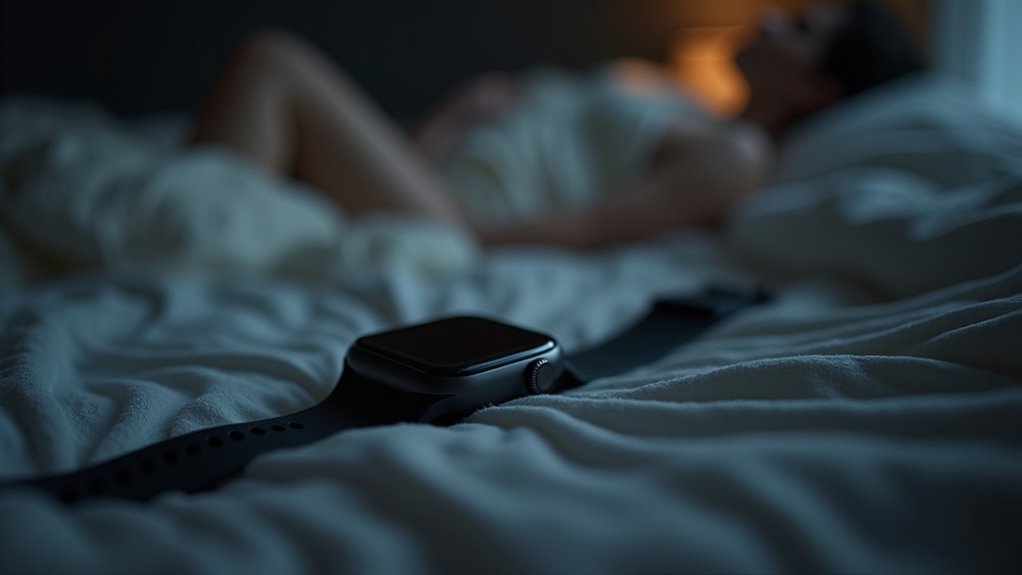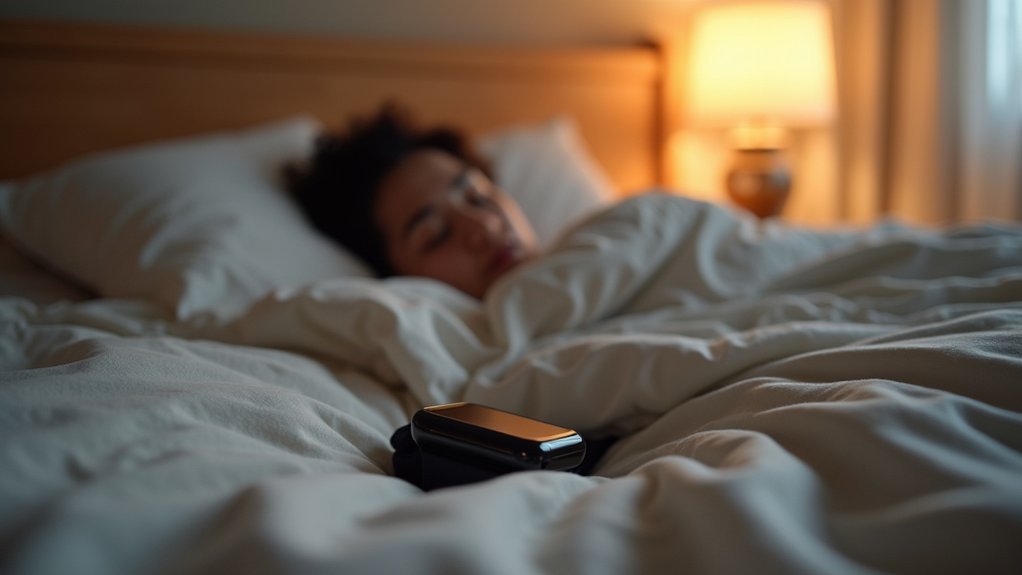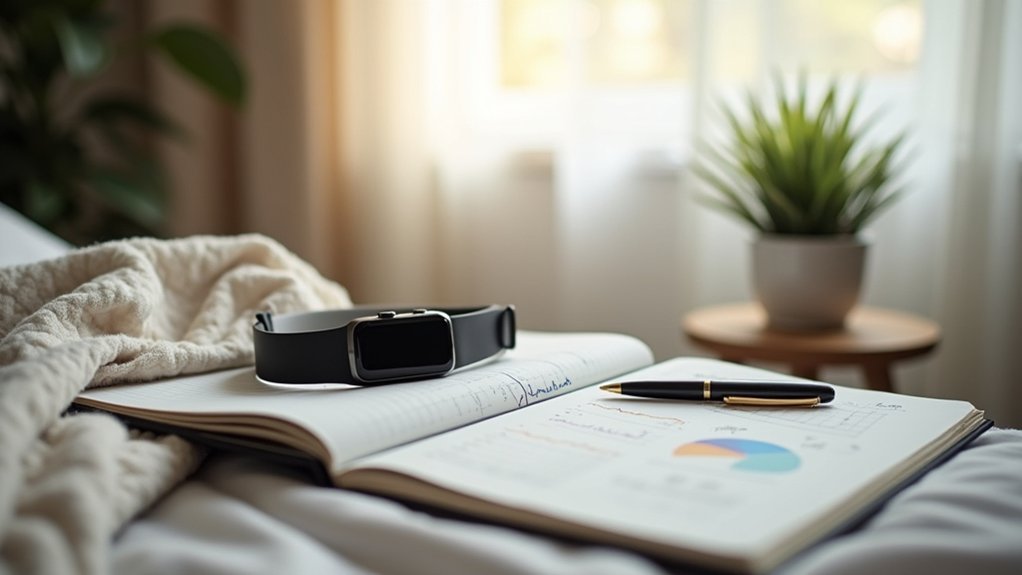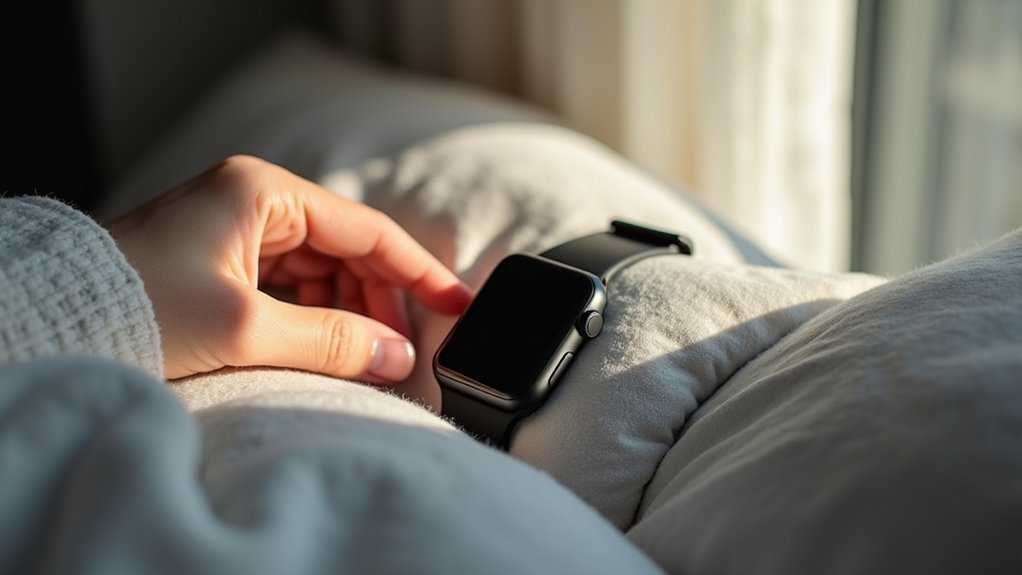Your body’s movement patterns during sleep provide essential insights into sleep quality and circadian health. Motion sensors track restlessness, tossing, and turning frequency to identify sleep disruptions with 90% accuracy when combined with heart rate data. Morning workouts reduce sleep onset time compared to evening exercise, which can disrupt rest within four hours of bedtime. Your core body temperature naturally drops before sleep, and monitoring these thermal changes reveals ideal timing for activities that’ll enhance your sleep architecture.
Sleep Stage Transitions and Physical Movement Correlations

As your body progresses through sleep’s various stages, distinct patterns of physical movement emerge that directly correlate with underlying neurological changes.
During Stage 1 NREM, you’ll experience marked muscle tension decreases as your body shifts into sleep. Your muscle tone continues dropping steadily through deeper NREM stages, reaching minimal movement levels during slow-wave sleep.
However, when REM sleep begins, muscle atonia kicks in, creating near-complete voluntary muscle paralysis that prevents you from acting out dreams.
You’re most likely to move during lighter NREM phases or stage shifts when autonomic responses fluctuate. Physical restlessness typically clusters around REM-to-NREM shifts rather than during prolonged REM periods, when your skeletal muscles remain inhibited despite increased brain activity.
These movement patterns can be tracked through EEG visualization, which allows researchers to correlate physical activity with specific brain wave changes throughout the night.
Decoding Nighttime Restlessness Through Motion Sensors
You can transform your understanding of sleep quality by using motion sensors to track disruptions throughout the night.
These devices employ restlessness pattern recognition technology that identifies specific movement signatures indicating poor sleep quality or underlying health conditions.
The sensor data provides actionable sleep insights, revealing when you’re tossing and turning most frequently and helping you pinpoint the root causes of your restless nights. Advanced systems can capture significant sleep events with motion-triggered recording, automatically documenting disturbances that might otherwise go unnoticed by traditional monitoring methods.
Motion Tracking Sleep Disruptions
When you toss and turn throughout the night, motion sensors in wearable devices capture these movements through accelerometers, transforming your restless sleep into valuable data about sleep disruptions.
These devices achieve about 90% accuracy in distinguishing sleep from wake when combined with heart rate metrics like HRV.
Your movement patterns reveal specific types of sleep disturbances. Increased movement frequency correlates with fragmented sleep and restlessness episodes that can indicate conditions like insomnia or periodic limb movement disorder.
Motion analysis highlights nocturnal awakenings that greatly impact your sleep quality and daytime function.
However, motion-only tracking struggles with precision, often misclassifying quiet wakefulness as sleep due to low specificity for wake detection during stillness periods. Individual characteristics such as skin color and obesity can influence device performance and accuracy, potentially creating disparities in sleep tracking effectiveness.
Restlessness Pattern Recognition Technology
Beyond simple movement detection, advanced pattern recognition technology transforms raw motion sensor data into meaningful insights about your nighttime restlessness behaviors.
You’ll benefit from sophisticated algorithms that analyze your room-to-room movement patterns, identifying subtle indicators of agitation or mood changes that might disrupt your sleep.
Strategic sensor placement throughout your home maximizes data collection while minimizing false readings. The technology tracks temporal sequences of your movements, creating predictive models that forecast potential restlessness episodes before they fully develop.
Machine learning algorithms continuously learn from your patterns, improving accuracy over time. You’ll receive thorough behavioral insights that reveal underlying causes of your restlessness, enabling proactive interventions.
Long-term monitoring identifies concerning trends, while multi-sensor integration provides complete sleep environment analysis for ideal rest quality. Advanced systems can classify ten degrees of restlessness behaviors to provide more precise insights into your sleep disturbance patterns.
Sensor Data Sleep Insights
Although motion sensors capture vast amounts of raw data throughout the night, their true value emerges when sophisticated algorithms transform these signals into actionable sleep insights.
Your wearable device’s accelerometer detects movement across three axes, converting this information into digital signals that reveal your sleep patterns.
The analysis process follows three key steps:
- Activity counting – Motion frequency and duration get recorded throughout each sleep cycle
- Threshold classification – Algorithms determine sleep/wake states based on movement intensity levels
- Pattern recognition – Your unique movement signatures get calibrated for personalized accuracy
You’ll receive real-time insights through companion apps that automatically sync your data.
However, remember that sensor-based tracking can’t match laboratory polysomnography’s precision, though it provides convenient home monitoring for general sleep pattern awareness. New systems utilizing radar technology can enhance data collection by tracking micromovements that traditional accelerometers might miss.
Optimal Exercise Timing for Enhanced Sleep Architecture
Your body’s internal clock doesn’t just track when you sleep—it also responds powerfully to when you move.
Morning workouts can dramatically reduce the time it takes you to fall asleep, while evening exercise within four hours of bedtime often backfires by keeping you alert longer.
Understanding your personal timing preferences becomes essential since high-strain evening sessions consistently disrupt sleep quality, even though some people swear by their late-day gym routine. Resistance exercise at any time improves overall sleep quality compared to sedentary days, with participants experiencing fewer nighttime awakenings regardless of workout timing.
Morning Exercise Benefits
When you exercise in the morning, you’re not just starting your day with energy—you’re programming your body for superior sleep that night. Your 7 AM workout delivers the most powerful nocturnal blood pressure reduction compared to afternoon or evening sessions, thanks to decreased catecholamines and cortisol throughout your waking hours.
Morning exercise transforms your sleep architecture through three key mechanisms:
- Hormonal optimization – You’ll experience considerably lower nighttime cortisol and increased melatonin production, creating ideal conditions for sleep initiation.
- Enhanced deep sleep – Your slow-wave sleep increases while reducing disruptive REM fluctuations.
- Faster sleep onset – You’ll fall asleep quicker with fewer nighttime awakenings.
These physiological changes particularly benefit older adults with insomnia, objectively improving sleep parameters even when subjective improvements aren’t immediately apparent. Research with university students demonstrates that 71.4% of morning exercisers report better sleep quality compared to just 44.1% of those who work out in the evening.
Evening Workout Risks
Despite evening workouts offering some sleep benefits, they create a physiological paradox that can sabotage your nighttime recovery. Your body temperature, heart rate, and arousal levels spike during exercise, directly opposing the natural sleep preparation process where these functions should decline.
Vigorous exercise within one hour of bedtime prevents your core temperature from cooling properly, delaying sleep onset and fragmenting your rest. Lengthy sessions exceeding 90 minutes correlate with poorer sleep quality scores, while post-exercise muscle soreness can persist into bedtime, disrupting sleep initiation.
However, you can minimize these risks by ending moderate workouts at least 90 minutes before bed and keeping late evening sessions shorter and lighter in intensity. Research analyzing 23 studies found that most healthy adults experienced no adverse sleep effects from evening exercise when properly timed.
Individual Timing Preferences
Individual chronotypes and circadian rhythms create unique exercise-sleep relationships that determine your ideal workout timing. Your personal sleep-wake patterns directly influence how exercise affects your nightly rest, making customized timing essential for maximum benefits.
Consider these timing strategies based on your natural rhythm:
- Morning workouts help you fall asleep faster and work best if you’re naturally an early riser with peak energy in the AM hours.
- Afternoon exercise provides moderate sleep benefits but typically has less impact on sleep onset compared to morning sessions.
- Evening workouts (excluding vigorous intensity) can improve sleep maintenance and reduce nighttime awakenings for some individuals.
Schedule your exercise sessions around your personal alertness peaks to synchronize with your circadian rhythms, enhancing both sleep architecture and daytime functioning. Research demonstrates that high intensity exercise interventions produce superior sleep quality improvements compared to moderate-intensity programs.
Circadian Rhythm Alignment Using Movement Data
Your body operates on a sophisticated 24-hour internal clock that governs everything from hormone production to sleep patterns. Modern wearable technology has revolutionized how we can track and enhance this circadian rhythm through movement data analysis.
Wearable devices capture your rest-activity patterns, revealing how well your daily movements align with your natural circadian cycles. This data helps identify sleep fragmentation, irregular activity patterns, and phase delays that disrupt ideal rhythm alignment.
Exercise timing becomes essential—morning physical activity acts as a powerful zeitgeber, synchronizing your internal clock with environmental cues. Studies show that increased circadian rhythm amplitude correlates with lower all-cause mortality and reduced incidence of various diseases.
Advanced algorithms analyze your movement data longitudinally, providing personalized feedback to improve circadian health. By maintaining consistent activity routines and understanding your movement patterns, you’ll enhance sleep quality and overall circadian alignment.
Body Temperature Fluctuations and Sleep Quality Metrics

While your movement patterns provide valuable insights into circadian alignment, your body’s thermal regulation offers an equally powerful window into sleep quality that most people overlook.
Your core body temperature naturally drops as you prepare for sleep, and this decline directly predicts how quickly you’ll fall asleep and how deeply you’ll rest. The posterior hypothalamus in your brain detects these temperature changes and coordinates the cooling process essential for quality sleep.
Understanding thermal regulation helps optimize your sleep environment:
- Monitor your skin temperature changes – Your distal skin temperature rises as your core temperature falls, signaling readiness for sleep.
- Track your pre-sleep temperature decline rate – A steeper drop indicates better sleep timing and quality.
- Maintain your bedroom between 60-67°F – This range supports your body’s natural cooling process.
Disruptions in this thermal rhythm often reveal why you’re experiencing poor sleep quality.
Wearable Technology Insights for Movement Pattern Analysis
Modern wearable devices transform how we decode the subtle movement patterns that reveal sleep quality insights. Your wrist-worn accelerometer captures motion intensity and frequency throughout the night, while optical heart rate sensors add essential physiological context for accurate sleep stage estimation.
When you combine these technologies, you’ll achieve around 70% accuracy compared to clinical sleep studies.
You can identify restless periods through increased movement intensity, which fragments your restorative sleep cycles. Long motionless intervals versus brief activity bursts reveal your sleep efficiency patterns.
Your device’s 30-second epoch data enables detailed analysis of sleep onset delays and wake disruptions.
This quantified movement data lets you tailor sleep interventions by correlating specific motion disruptions with environmental factors, ultimately optimizing your rest-activity rhythms. Unlike PSG testing conducted in clinical facilities, wearable devices provide the comfort of monitoring sleep patterns in your natural bedroom environment.
Personalizing Activity Schedules Based on Sleep Feedback

How can sleep data transform your daily schedule from generic to genuinely optimized? Your wearable devices continuously track sleep-wake patterns, feeding mathematical models that predict your real-time alertness levels.
These systems don’t just monitor—they actively recommend when you’ll perform best at specific activities. Modern frameworks integrate your circadian rhythm analysis with dynamic sleep pressure tracking, creating truly personalized schedules.
For shift workers, adaptive circadian split sleep (ACSS) combines primary sleep periods with strategic naps to maintain peak performance during unconventional hours.
The personalization process involves three key components:
- Real-time alertness prediction that adjusts your activity timing
- Sleep feedback systems that inform daily recommendations
- Mobile app integration that considers your preferences and sleep history
You’ll experience reduced errors during critical tasks and improved cardiometabolic health—with 1-point sleep improvements correlating to 10% reduced health risks. Research using under-mattress sensors demonstrates the feasibility of implementing rule-based coaching infrastructure that leverages passive sleep data collection for continuous wellness monitoring.
Frequently Asked Questions
How Long Should I Wait After Eating Before Exercising for Better Sleep?
You should wait 2-3 hours after moderate-to-large meals before exercising. This timing prevents digestive discomfort, optimizes performance, and reduces post-exercise arousal that could disrupt your sleep onset later.
Can Yoga or Stretching Replace Cardio for Improving Sleep Quality?
You can use yoga or stretching instead of cardio for sleep improvements, but you’ll get more modest benefits. Cardio provides superior deep sleep enhancement, while yoga excels at relaxation and stress reduction.
Do Sleep Medications Interfere With Exercise-Induced Sleep Benefits?
Sleep medications can interfere with your exercise-induced sleep benefits by altering natural sleep architecture and blunting physiological responses. They may mask genuine sleep improvements from physical activity rather than enhancing them.
How Does Caffeine Consumption Affect the Exercise-Sleep Relationship?
Caffeine disrupts your exercise-sleep benefits by reducing deep sleep stages essential for recovery. You’ll experience shorter sleep duration and fragmented rest, undermining the restorative processes that exercise typically enhances for better sleep quality.
What Role Does Hydration Play in Post-Exercise Sleep Quality?
Your hydration status directly affects post-exercise sleep quality by regulating body temperature and supporting REM sleep. You’ll experience better sleep efficiency when you’re properly hydrated, especially after exercise-induced mild dehydration.
In Summary
You’ve got the tools to revolutionize your rest by tracking movement patterns. Your wearable devices aren’t just counting steps—they’re revealing when you toss, turn, and shift between sleep stages. Use this data to time your workouts, sync your circadian rhythms, and monitor temperature fluctuations that affect sleep quality. You’ll discover your unique movement signature and create personalized activity schedules that work with your body’s natural patterns for deeper, more restorative sleep.





Leave a Reply